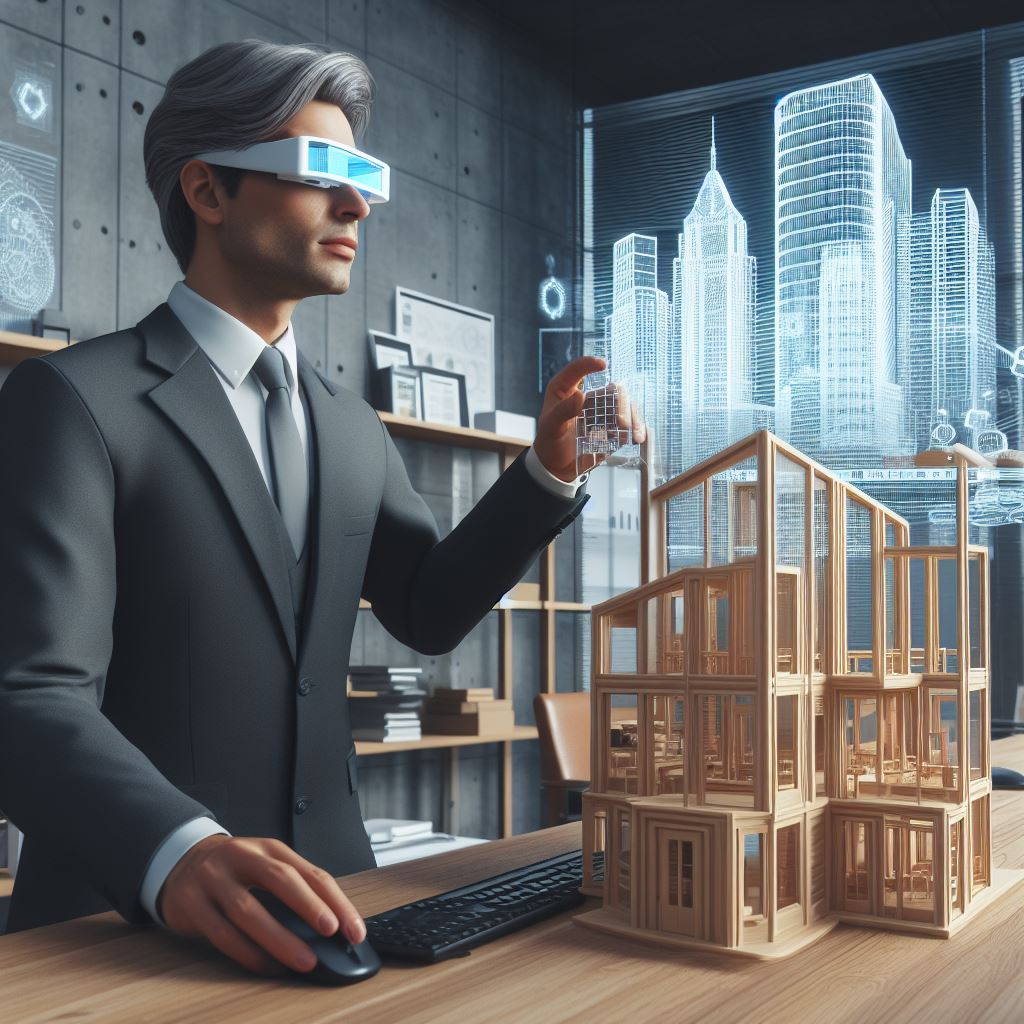Introduction
A. Definition of augmented reality
Augmented reality (AR) is a technology that overlays digital content onto the real world. It enhances the user’s perception and interaction with their environment.
AR has gained popularity and is being used in various industries such as gaming, healthcare, and retail.
In property viewing, AR allows potential buyers to visualize properties before visiting them in person.
It provides an immersive experience by superimposing digital images and information onto the physical space.
With AR, users can see how furniture would fit into a room or explore different design options.
AR is revolutionizing the property viewing process as it saves time and offers convenience.
Buyers can virtually tour multiple properties without physically visiting each one.
This technology also enhances decision-making as buyers can accurately judge the scale and dimensions of a property.
B. Rise of augmented reality in various industries
The rise of AR in property viewing has been accelerated by advancements in mobile devices and applications.
With smartphones and tablets becoming more powerful, AR applications have become easily accessible to users.
Real estate companies are incorporating AR into their digital platforms to provide an interactive and engaging experience for potential buyers.
Moreover, AR is not limited to residential properties. It is being used in commercial real estate as well.
Retailers can use AR to showcase their products within a space, giving customers an idea of how products would appear in a physical store.
This technology has the potential to transform the way properties are marketed and sold.
In general, augmented reality is revolutionizing property viewing by providing an immersive and interactive experience.
Its rise in various industries, including real estate, highlights its potential and the benefits it offers to both buyers and sellers.
Benefits of Augmented Reality in Property Viewing
Augmented reality in property viewing has revolutionized the way clients interact with real estate.
By leveraging AR technology, potential buyers can experience a property virtually before making a physical visit.
This innovative approach has numerous benefits that enhance the overall property viewing experience.
A. Enhanced Visualization
Augmented reality allows clients to visualize a property as if they were physically present.
With the help of AR apps, buyers can virtually explore various rooms, adjust furniture placement, and experience the property’s ambiance in real-time.
This immersive experience gives them a comprehensive understanding of the property’s potential.
B. Time-saving for both buyers and sellers
Traditionally, property viewings required substantial time investment from both buyers and sellers.
However, with augmented reality, potential buyers can virtually tour multiple properties without leaving their homes.
This saves time and effort for everyone involved and enables them to narrow down their choices efficiently.
C. Opportunity for virtual staging
One of the significant advantages of augmented reality in property viewing is the opportunity for virtual staging.
Instead of physically staging a property with furniture and decor, sellers can digitally stage it.
This allows buyers to see the property’s full potential, helping them visualize how their furniture and personal style would fit within the space.
D. Improved decision-making process for customers
Augmented reality empowers potential buyers to make better-informed decisions.
By virtually experiencing a property, they can assess its suitability based on their preferences, needs, and lifestyle.
This helps them avoid wasting time visiting properties that do not meet their requirements, ultimately streamlining the decision-making process.
In essence, the benefits of augmented reality in property viewing are remarkable.
This technology offers enhanced visualization, saves time for both buyers and sellers, provides the opportunity for virtual staging, and improves the decision-making process for customers.
As the real estate industry continues to embrace technological advancements, augmented reality is proving to be a game-changer in creating a more immersive and efficient property viewing experience.
Real-life Applications of Augmented Reality in Property Viewing
In recent years, the emerging technology of augmented reality (AR) has revolutionized various industries,
and one such industry which has embraced AR is property viewing.
Let’s explore the real-life applications of AR in property viewing:
A. Virtual property tours
AR allows potential buyers to take virtual tours of properties without physically visiting them.
They can use their smartphones or AR devices to view 3D models of properties from anywhere.
This immersive experience provides a realistic representation of the property and saves time for buyers.
B. Furniture placement and customization
AR enables users to visualize and place virtual furniture in real-time within the property.
Buyers can experiment with different furniture layouts and designs to assess their preferences.
This technology helps in making informed decision for furniture selection and customization before purchasing.
C. Interior design and remodeling simulations
AR allows users to simulate interior designing and remodeling options in a property.
By overlaying virtual elements, users can visualize various design possibilities and modifications in real-time.
This feature helps homeowners and professionals in planning and executing interior design projects effectively.
D. Construction and renovation planning
For architects, builders, and contractors, AR assists in planning and visualizing construction and renovation projects.
They can superimpose designs and architectural models onto the real property, facilitating accurate measurements and assessments.
This technology aids in efficient project management, reducing errors, and improving communication among stakeholders.
Therefore, the application of augmented reality in property viewing has widened the horizons for both buyers and professionals.
Virtual property tours save time, furniture placement customization simplifies decision-making, interior design simulations aid planning, and construction/renovation planning enhances project management.
As AR technology continues to evolve, the future of property viewing holds even more exciting possibilities.
It is safe to say that augmented reality has transformed and will continue to revolutionize the property industry.
Read: Building Credit: A First-Time Buyer’s Must-Do
Examples of Augmented Reality Property Viewing Tools and Platforms
Augmented Reality (AR) technology has revolutionized the way people view properties.
With the help of AR, potential buyers can now experience virtual property tours without physically visiting a location.
In this blog section, we will explore some examples of AR tools and platforms used in property viewing.
1. AR Mobile Applications
- AR mobile applications have paved the way for immersive property viewing experiences.
- These apps use the camera and sensors of smartphones to overlay virtual information on the real world.
- Users can simply point their device towards a property, and the app will provide real-time information about it.
- These applications can display property details, floor plans, furniture arrangements, and even simulate interior design options.
2. Virtual Reality Headsets
- Virtual Reality (VR) headsets offer a more immersive property viewing experience.
- Users can wear these headsets and feel as if they are physically present within a property.
- They can explore different rooms, walk through hallways, and even look out of windows.
- VR headsets create a sense of depth and scale, providing potential buyers with a realistic understanding of the property.
3. Interactive Websites
- Interactive websites with AR capabilities allow users to view properties remotely.
- These websites provide interactive 3D models of properties, accessible through any device with a web browser.
- Users can rotate the models, explore different rooms, and get a comprehensive idea of the property’s layout.
- Some websites even integrate additional features like virtual staging, which shows how a property could look with different furniture arrangements.
4. Collaborative Platforms for Real Estate Agents and Clients
- Collaborative platforms enable real estate agents and clients to interact and view properties together.
- These platforms offer features like live video streaming, shared virtual tours, and real-time communication.
- Agents can guide clients through properties remotely, answering questions and providing instant feedback.
- Clients can actively participate in the viewing process, making it more engaging and personalized.
Augmented Reality has transformed property viewing, making it more convenient and accessible for potential buyers.
Whether through AR mobile applications, virtual reality headsets, interactive websites, or collaborative platforms, users can now explore properties remotely with a realistic perspective.
The efficiency of these tools and platforms benefits both buyers and sellers.
Buyers can save time and effort by narrowing down options before physically visiting properties, while sellers can attract more potential buyers by offering immersive virtual tours.
Additionally, AR property viewing can be particularly useful in situations where physical visits may not be feasible, such as during a pandemic or for international buyers.
As technology continues to advance, we can expect even more sophisticated AR tools and platforms to emerge.
With advancements in augmented reality and virtual reality, property viewing experiences are becoming more interactive, informative, and engaging for all parties involved.
In a nutshell, the examples mentioned above showcase the varied applications of augmented reality in property viewing.
From the convenience of AR mobile applications to the immersive experience provided by virtual reality headsets, these tools and platforms have revolutionized the way people explore properties.
As the technology continues to evolve, the future of property viewing looks increasingly promising.
Read: Decoding Real Estate Terms for New Buyers

Challenges and Limitations of Augmented Reality in Property Viewing
Augmented reality (AR) has revolutionized the way we experience the world, and its impact on the real estate industry has been significant.
However, like any new technology, AR in property viewing comes with its own set of challenges and limitations that need to be addressed for its widespread adoption.
A. Sufficient User Adoption and Awareness
- Despite the growing popularity of AR, many potential users are still unfamiliar with its capabilities.
- Education and marketing efforts are required to increase awareness and encourage adoption among property buyers.
B. Connectivity and Technical Requirements
- AR applications rely heavily on stable and high-speed internet connections, which may not be available in all areas.
- Additionally, certain technical requirements, such as powerful hardware and compatible devices, can limit access to AR experiences.
C. Privacy and Security Concerns
- AR property viewing involves capturing and processing sensitive data, including personal information and property details.
- Data protection measures must be implemented to safeguard user privacy and prevent unauthorized access.
D. Potential Limitations in Accuracy and Realism
- While AR can provide a simulated view of a property, it may not always capture the full accuracy or realism of the physical environment.
- Factors like lighting conditions and spatial limitations can affect the fidelity of AR property viewing experiences.
Despite these challenges and limitations, the benefits of AR in property viewing cannot be overlooked.
It empowers potential buyers to virtually walk through properties, visualize renovations, and make informed decisions.
To overcome these challenges, various strategies can be implemented:
1. Enhanced User Training and Support
Offering comprehensive training programs and user-friendly interfaces can help new users navigate AR property viewing experiences confidently.
2. Improving Connectivity Infrastructure
Investments in internet infrastructure and improving connectivity in underserved areas can ensure that AR experiences are consistently accessible.
3. Strict Privacy and Security Protocols
Implementing robust data encryption and secure access controls can alleviate user concerns and foster trust in AR property viewing platforms.
4. Ongoing Technological Advancements
Continued research and development in AR technology can address accuracy and realism limitations, leading to more immersive property viewing experiences.
Essentially, while challenges and limitations exist, AR has immense potential in revolutionizing the property viewing experience.
Through increased adoption, improved connectivity, enhanced security, and technological advancements, AR can become an indispensable tool for buyers and real estate professionals.
Read: Smart Strategies for Down Payment Savings
Delve into the Subject: E-Signatures & Online Notaries in RE
Future Trends and Possibilities for Augmented Reality in Property Viewing
A. Integration with artificial intelligence and machine learning
- Augmented reality (AR) can be further enhanced through integration with artificial intelligence (AI) and machine learning.
- AI algorithms can analyze user preferences and provide personalized property recommendations within AR applications.
- Machine learning can improve AR’s ability to recognize and simulate realistic property features for a more immersive experience.
- AI-powered chatbots can be integrated with AR property viewing, providing real-time assistance and answering inquiries.
B. Enhanced interactivity and customization options
- Augmented reality offers the potential for enhanced interactivity by allowing users to virtually customize and personalize properties.
- Users can visualize different interior designs, furniture arrangements, and color schemes within the AR environment.
- Customization options can extend to exterior features, such as landscaping and architectural modifications.
- AR can also allow users to virtually measure dimensions and test out different layouts to better visualize the potential of a property.
C. Expansion into commercial real estate and property management
- While AR property viewing has primarily been utilized in residential real estate, there is considerable potential for expansion into the commercial sector.
- Commercial property developers and brokers can leverage AR to showcase office spaces, retail environments, and industrial facilities.
- AR can aid in marketing efforts by offering virtual tours and interactive presentations, saving time and resources for potential clients.
- Property management companies can embrace AR to facilitate facility management, allowing tenants to report issues and access property information using AR applications.
D. Potential for AR utilization in property valuations and inspections
- Augmented reality can revolutionize property valuations by providing real-time data overlays on physical properties.
- AR can assist appraisers and inspectors in identifying structural or maintenance issues during property inspections.
- Virtual overlays can display property information, historical sales data, and current market trends for informed decision-making.
- AR can streamline the valuation process, improving accuracy and reducing the need for multiple site visits.
Generally, the future of augmented reality in property viewing holds numerous exciting possibilities.
Integration with artificial intelligence and machine learning can enhance user experiences and personalize property recommendations.
Enhanced interactivity and customization options can revolutionize property visualization and interior design planning.
Furthermore, the expansion of AR into commercial real estate and property management offers new avenues for leveraging this technology.
Lastly, the potential utilization of AR in property valuations and inspections can improve efficiency and accuracy in the real estate industry.
As technology continues to evolve, augmented reality is poised to revolutionize the way we view and interact with properties.
Read: Finding Your Dream Home: A Starter Guide
Conclusion
Augmented reality in property viewing offers numerous benefits and applications.
It enhances the property viewing experience by providing virtual tours and realistic visualizations.
Augmented reality also saves time and resources for both buyers and sellers by allowing remote viewing and reducing the need for physical visits.
The future advancements in augmented reality hold great anticipation.
With the development of more sophisticated technologies, the possibilities for enhanced property viewing experiences are endless.
The overall impact of augmented reality on the real estate industry is significant.
It revolutionizes the way properties are marketed and viewed, making it more engaging and interactive.




